I’m excited to delve into the topic of adopting stray cats and explore the cost associated with this heartwarming endeavor. Adopting a stray cat comes with its own set of considerations and costs, but the rewards of providing a forever home to a furry friend are immeasurable. Let’s explore the important factors that go into determining the cost of adopting a stray cat.
Key Takeaways:
- Adopting a stray cat involves understanding the costs and factors that contribute to the adoption fees.
- Consider the source of adoption, such as animal shelters, private rescue groups, or cat breeders, as they may have different fee structures.
- Adoption fees typically cover veterinary care, including vaccinations, spaying or neutering, and microchipping.
- Purebred kittens from cat breeders may have higher adoption fees, but research and choose a reputable breeder for a healthy and well-cared-for kitten.
- Helping stray cats goes beyond adoption, and you can make a difference through spaying or neutering, providing food and shelter, volunteering, or donating to organizations.
Where Can You Adopt a Cat?
When it comes to adopting a cat, there are several options available. Whether you prefer to adopt from an animal shelter, a private rescue group, or even a cat breeder, each option offers its own unique benefits. It’s important to do your research and consider your preferences and requirements before making a decision.
Animal Shelters:
Animal shelters are a popular choice for cat adoption. They often have a variety of cats available, including both adult cats and kittens. Adoption fees at animal shelters usually include essential veterinary care such as checkups, vaccinations, spaying or neutering, and microchipping. Some shelters even run promotions that waive the adoption fee, making it an affordable option for potential cat owners.
Private Rescue Groups:
Private rescue groups also offer cats and kittens for adoption. These organizations may focus on specific breeds or types of cats, allowing you to find the perfect match for your lifestyle. Similar to animal shelters, adoption fees at private rescue groups typically cover veterinary care, ensuring that your new feline friend is healthy and ready to settle into their forever home.
Cat Breeders:
If you have a specific breed in mind, adopting a purebred kitten from a cat breeder might be the right choice for you. Keep in mind that adoption fees for purebred kittens are generally higher compared to adopting from a shelter or rescue group. It’s important to choose a reputable breeder who prioritizes the health and well-being of their cats, offering services such as vaccinations and microchipping. However, spaying or neutering may not be included, so it’s important to discuss these details with the breeder.
| Adoption Option | Benefits |
|---|---|
| Animal Shelters | – Wide variety of cats available – Adoption fees often include essential veterinary care – Promotions may waive adoption fees |
| Private Rescue Groups | – Option to find specific breeds or types of cats – Adoption fees cover veterinary care – Cats are generally well-cared for by the organization |
| Cat Breeders | – Ability to adopt a specific breed – Kittens are usually well-bred and healthy – Services like vaccinations and microchipping may be included |
By exploring these options, you can find the perfect cat to join your family. Whether you choose to adopt from an animal shelter, a private rescue group, or a cat breeder, you’ll be providing a loving home for a cat in need. Remember, adoption fees help support the organizations in their mission to care for and rehome cats, making a difference in the lives of these feline companions.
Animal Shelter Adoptions
When it comes to adopting a cat, animal shelters are a great option. They often have both adult cats and kittens available for adoption. The adoption fee at an animal shelter typically includes various veterinary care services, such as checkups, vaccinations, spaying or neutering, and microchipping. This ensures that the cat you adopt is healthy and up to date on necessary medical procedures.
Animal shelters play a vital role in finding homes for stray and abandoned cats. By adopting from a shelter, you not only give a loving home to a cat in need, but you also support the important work that shelters do to care for these animals. Plus, many shelters run promotions where they waive the adoption fee, making it even more affordable to bring a new furry friend into your life.
If you’re considering adopting a cat, be sure to visit your local animal shelter. They have a wide variety of cats with different personalities and temperaments, so you’re sure to find one that is the perfect fit for your family. And remember, when you adopt from an animal shelter, you’re not just getting a pet – you’re making a difference in the life of a deserving cat.
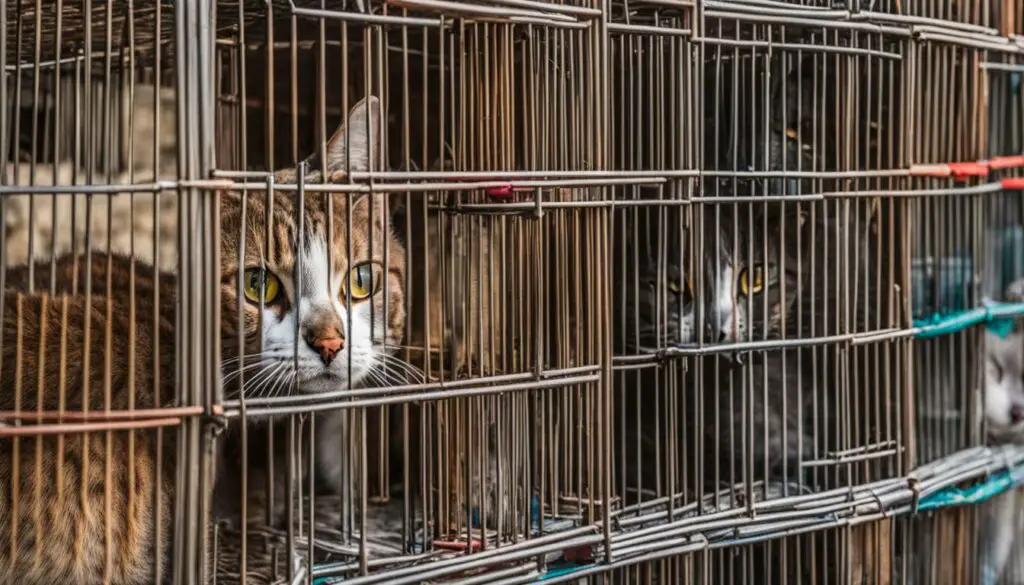
| Adoption Fee | Veterinary Care Included |
|---|---|
| $0 – $200 | Checkups, vaccinations, spaying or neutering, microchipping |
| Promotions | Some shelters may waive the adoption fee for a limited time |
Private Rescue Group Adoptions
When it comes to adopting a cat, private rescue groups are another great option to consider. These organizations focus on rescuing and rehoming both adult cats and kittens, often specializing in specific breeds or types of cats. Private rescue groups play a crucial role in providing a safe and loving environment for cats in need.
One advantage of adopting from a private rescue group is that their adoption fees typically cover essential veterinary care. This includes checkups, vaccinations, spaying or neutering, and microchipping. By adopting from a private rescue group, you can be confident that your new furry companion has received the necessary medical attention to ensure their well-being.
Just like with animal shelters, the adoption fee for private rescue groups can vary. It is important to research and compare different organizations to find the one that aligns with your preferences and budget. By supporting a private rescue group through adoption, you are not only giving a deserving cat a forever home but also contributing to the valuable work these organizations do.

Benefits of Private Rescue Group Adoptions
There are several benefits to adopting a cat from a private rescue group. Firstly, you have the opportunity to provide a home to a cat in need and make a significant difference in their life. Secondly, private rescue groups often have a deep understanding of the cats in their care, including their personalities and behavior traits. This knowledge can help ensure a successful match between you and your new feline friend.
Additionally, adopting from a private rescue group allows you to support their mission of saving and rehoming cats. Many private rescue groups rely on donations and volunteers to continue their important work, so your adoption fee goes towards supporting their ongoing efforts.
Cat Breeder Adoptions
If you’re interested in a specific breed, you can choose to adopt a purebred kitten from a cat breeder. The adoption fee for a purebred kitten is usually higher than adopting from a shelter or rescue group. However, it may not include spaying or neutering or a microchip. It’s important to research and choose a reputable breeder who offers a health guarantee for the kitten.

Important Considerations when Adopting from a Cat Breeder
- Research and choose a reputable breeder who follows ethical breeding practices.
- Ask for health certifications and guarantees to ensure the well-being of the kitten.
- Take into account the breed’s specific needs and temperament to ensure compatibility with your lifestyle.
- Consider the long-term financial commitment that comes with owning a purebred cat.
Adopting a purebred kitten from a cat breeder can be a rewarding experience if done responsibly. It allows you to choose a specific breed and enjoy the unique characteristics that come with it. Remember to prioritize the health and well-being of the kitten by selecting a reputable breeder and asking the right questions.
By adopting a purebred kitten from a cat breeder, you have the opportunity to provide a loving home to a beautiful and unique companion. However, it’s essential to consider the extra costs and responsibilities that come with owning a purebred cat. Make sure to do your research, ask the breeder the right questions, and ensure that the health and well-being of the kitten are prioritized before making the decision to adopt.
Feral and Stray Cats
When it comes to cats, there are different categories to consider. Feral and stray cats are a unique group that requires specialized attention and care. Unlike domesticated cats, feral and stray cats have not been socialized to live with humans and may not be suitable for adoption as pets. These cats often live outdoors and rely on their survival instincts to find food and shelter.
One approach to addressing the issue of feral cat populations is through a method known as trap-neuter-return (TNR). TNR involves trapping feral cats, sterilizing them through spaying or neutering, and returning them to their environment. This approach helps control the population by preventing further breeding while allowing the cats to live out their lives in their familiar surroundings.
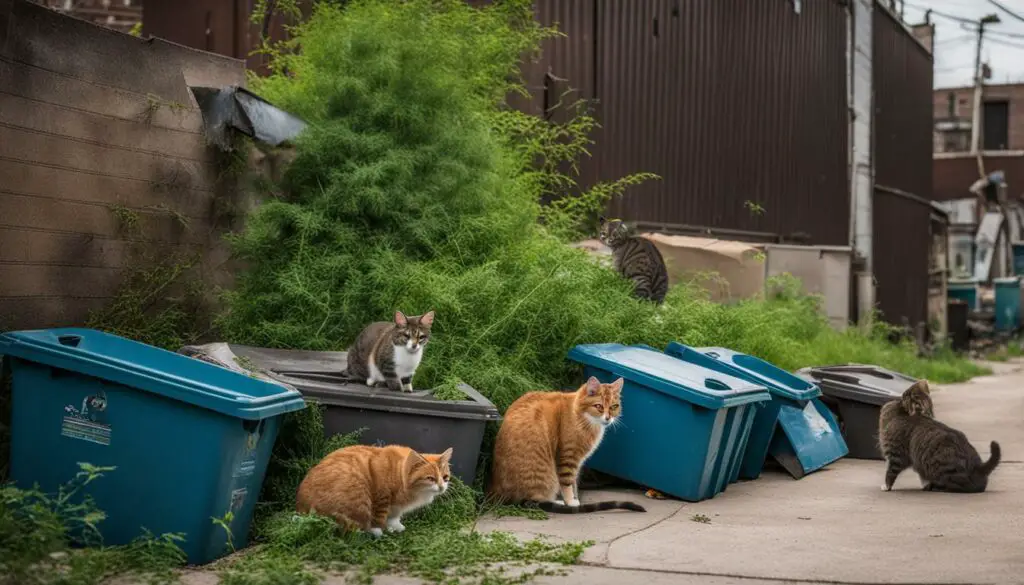
Implementing TNR programs has proven to be an effective and humane method of managing feral cat populations. By neutering or spaying the cats, TNR helps prevent the birth of more kittens, reducing the number of feral cats over time. Additionally, TNR programs have been endorsed by reputable organizations such as the ASPCA and the Humane Society.
The Benefits of Trap-Neuter-Return Programs:
- Improved Health: Through TNR, feral cats receive veterinary care, including vaccinations and medical check-ups, which helps improve their overall health and well-being.
- Reduced Behaviors: Neutering or spaying feral cats can help reduce fighting, marking behaviors, and other negative behaviors associated with mating instincts.
- Population Control: By preventing the birth of more kittens, TNR programs contribute to population control, ultimately reducing the number of feral cats in a community.
Overall, TNR programs play a crucial role in managing feral cat populations in a humane and effective manner. These programs not only address the immediate issue of overpopulation but also help improve the health and well-being of feral cats. By supporting and promoting trap-neuter-return initiatives, we can make a positive impact on the lives of these cats and the communities they inhabit.
Neutering Programs for Feral Cats
Neutering programs, such as trap-neuter-return (TNR), are effective and humane methods for managing feral cat populations. These programs aim to reduce the number of feral cats through sterilization, preventing further breeding and the exponential growth of the population. TNR programs have been endorsed by reputable organizations such as the ASPCA and the Humane Society.
Benefits of neutering programs for feral cats are manifold. Firstly, sterilization improves the overall health and well-being of feral cats by reducing the risk of reproductive-related diseases such as testicular and mammary tumors. Neutered cats also exhibit reduced aggressive behaviors, such as fighting and territorial marking, which can lead to injuries and conflict with other cats in the area.
Moreover, neutering programs play a crucial role in population control. By sterilizing feral cats and preventing the birth of new litters, these programs help to stabilize and reduce the size of feral cat populations over time. This is particularly important considering the challenges associated with finding suitable homes for feral cats, as their lack of socialization often makes them unsuitable for adoption as pets.
| Benefits of Neutering Programs for Feral Cats |
|---|
| Improved health and well-being of feral cats |
| Reduced aggressive behaviors |
| Population control and stabilization |
Neutering programs for feral cats are an essential component of responsible and compassionate feral cat management. By addressing the root causes of population growth and promoting the health and welfare of feral cats, these programs contribute to the overall well-being of both the cats and the communities they inhabit.
Controversies Surrounding Feral Cat Management
The management of feral cats is a subject of ongoing debate, with differing opinions on the best approach. Some argue for the eradication or relocation of feral cats, believing that removing them entirely from an area is the most effective solution. Others advocate for trap-neuter-return (TNR) programs, which involve trapping feral cats, sterilizing them, and returning them to their original location.
One of the main controversies surrounding feral cat management is the effectiveness of TNR programs. Proponents of TNR argue that it is a humane and compassionate approach, as it prevents the breeding cycle and reduces the population over time. They also highlight the health benefits for sterilized cats, such as reduced risks of certain diseases and injuries.
However, critics of TNR argue that it is not a long-term solution. They claim that the “vacuum effect” undermines the effectiveness of TNR. This effect refers to the phenomenon where removing feral cats from an area creates a vacuum that attracts new cats to fill the void. Critics believe that eradication or relocation is necessary to address the root cause of feral cat overpopulation.
| Approach | Pros | Cons |
|---|---|---|
| Eradication | – Permanently removes feral cats from the area – Reduces risks to native wildlife |
– Requires significant resources and ongoing efforts – Can be controversial and inhumane |
| Relocation | – Gives feral cats a chance to live in a safer environment – Reduces risks to native wildlife |
– Cats may struggle to adapt to new territory – Can be logistically challenging and costly |
| TNR Programs | – Humane approach that prevents the breeding cycle – Improves the health of sterilized cats |
– Effectiveness can be hindered by the “vacuum effect” – Requires ongoing efforts and community support |
Feral cat management is a complex issue with passionate arguments on both sides. It is important to consider the unique circumstances of each community and explore a combination of approaches that prioritize both the well-being of the cats and the protection of native wildlife.
Ways to Help Stray Cats
If you’re passionate about helping stray cats in your community, there are several ways you can make a difference. The well-being of these cats depends on individuals like us taking action and offering our support. Here are some ways you can help:
1. Spaying and Neutering: One of the most effective ways to control the stray cat population is by spaying and neutering them. This helps prevent further breeding and reduces the number of homeless cats on the streets.
2. Feeding: Providing food and water to stray cats can ensure they have access to basic necessities. Set up feeding stations in safe areas, away from busy roads, and make sure to provide fresh food and water regularly.
3. Volunteering: Get involved with local organizations or animal shelters that work with stray cats. You can offer your time and skills by volunteering at adoption events, assisting with trap-neuter-return programs, or even fostering stray cats until they find permanent homes.
4. Donating: Monetary donations can go a long way in supporting the care and well-being of stray cats. Consider donating to organizations that provide medical treatment, food, and shelter for these cats.
Remember, every effort counts, no matter how small it may seem. By taking action, we can make a positive impact on the lives of stray cats and help create a safer and more compassionate community for them.
Table: Ways to Help Stray Cats
| Ways to Help Stray Cats | Description |
|---|---|
| Spaying and Neutering | Prevents further breeding and controls the stray cat population. |
| Feeding | Provides essential food and water to stray cats in need. |
| Volunteering | Offer your time and skills to help organizations working with stray cats. |
| Donating | Supports the care and well-being of stray cats through monetary contributions. |
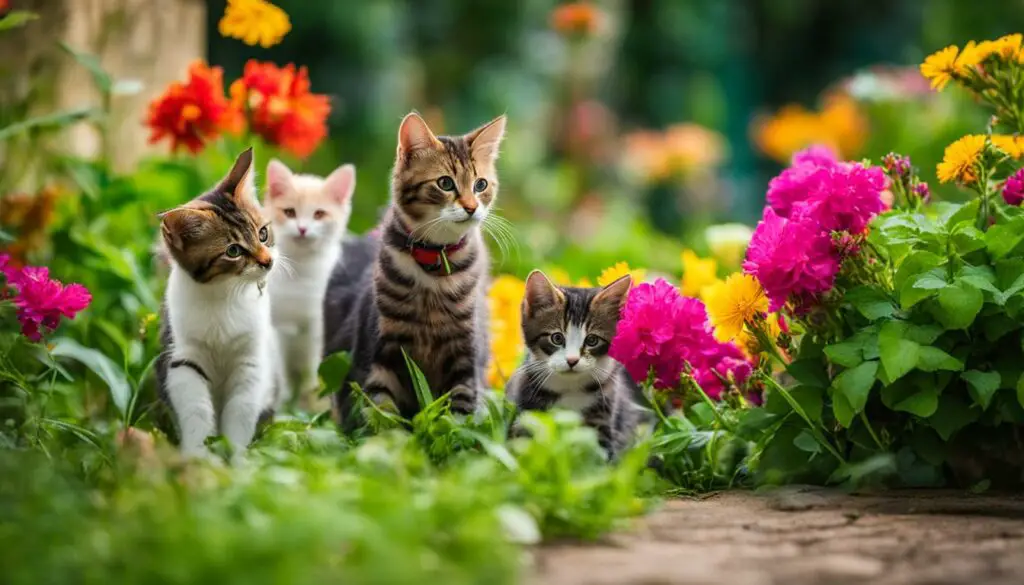
“Saving one cat won’t change the world, but for that one cat, the world will change forever.” – Author Unknown
Why Choose to Adopt a TLC Cat
Adopting a cat from Ten Lives Club (TLC) not only brings a furry companion into your life but also supports their mission of enhancing cat life. By choosing to adopt a rescue cat, you are actively contributing to the solution of pet overpopulation and showing that rescue cats are just as valuable and lovable as purebred cats. TLC ensures that all their cats are provided with necessary veterinary care, including spaying/neutering, vaccinations, microchipping, and treatment for fleas and worms.
Adopting a TLC cat offers numerous benefits, both for you and the cat. Firstly, you are giving a cat a second chance at a loving home, providing them with a safe and caring environment to thrive in. Adopted cats often display immense gratitude and loyalty, forming deep bonds with their new owners. Additionally, by adopting, you are helping break the cycle of pet overpopulation and reducing the number of stray and homeless cats.
Rescue cats, like those available at TLC, have significant value. They possess unique personalities and individual traits that make them special and endearing companions. Their experiences and resilience make them grateful for the love and care they receive in their new homes. Adopting a TLC cat not only brings joy and companionship to your life but also helps provide a loving future for a cat in need.

Not only do rescue cats bring love and happiness to their adoptive families, but they also offer potential health benefits. Research has shown that living with a cat can have positive effects on mental and physical well-being. Cats provide stress relief, companionship, and can even help lower blood pressure. Adopting a TLC cat gives you the opportunity to experience these health benefits while making a positive impact on a cat’s life.
Choosing the Right Cat to Adopt
When it comes to adopting a cat, finding the right fit for your home and lifestyle is crucial. Consider the cat’s personality, temperament, and how well they align with your own preferences and needs. While some people have specific breed or age preferences, keeping an open mind and focusing on compatibility will help you find the perfect companion.
Personality
Cats have unique personalities, just like people. Some cats may be outgoing and social, while others may be more independent and reserved. Think about what kind of personality traits you’re looking for in a cat. Do you want an affectionate lap cat or a playful and energetic companion? Understanding the cat’s personality can help ensure a harmonious match.
Temperament
The temperament of a cat refers to their overall disposition and behavior. Some cats are naturally more relaxed and laid-back, while others may be more active and adventurous. Consider your own lifestyle and energy level when choosing a cat with a compatible temperament. If you have a busy household or children, a cat who is tolerant and adaptable may be a better fit.
Lifestyle
It’s important to consider your lifestyle and how a cat will fit into it. Are you looking for a low-maintenance cat that can adapt to your busy schedule, or do you have more time to dedicate to a high-energy cat? Also, think about any specific needs or restrictions you may have, such as allergies or living in a small apartment. Finding a cat that can thrive in your environment will ensure a happy and fulfilling adoption.

In summary, when choosing a cat to adopt, take into account their personality, temperament, and how well they align with your lifestyle. Meeting the cat in person and spending time with them will give you a better understanding of their behavior and compatibility. Remember, adopting a cat is a lifelong commitment, so finding the right match is essential for both you and the cat’s well-being.
The Adoption Process
When you decide to adopt a TLC cat, there are a few steps you’ll need to follow to ensure a smooth adoption process. First, you can visit one of our adoption locations or browse our available cats online to find your new feline friend. Once you have chosen a cat you are interested in, you can schedule a meet and greet with one of our adoption coordinators.
During the meet and greet, you will have the opportunity to spend time with the cat, ask any questions you may have, and see if you and the cat are a good match for each other. It’s important to take your time during this process, as finding the right cat is essential for a successful adoption.
After you have found the perfect cat, you will need to complete the adoption paperwork. This includes providing a valid driver’s license, bringing a cat carrier for transportation, and paying the adoption fee. Our adoption fees vary depending on the age and special needs of the cat, ranging from $50 for senior cats or cats with special needs to $195 for kittens. We also offer pricing tiers for multiple cat adoptions. Keep in mind that the adoption fee is considered a donation and helps support the care and well-being of our cats.
Once the paperwork and payment are complete, it’s important to establish a primary veterinarian for your new cat. Regular veterinary care is essential for the health and happiness of your pet. Make sure your new cat receives a thorough check-up, vaccinations, and any necessary treatments to ensure they start their new life with you on the right paw.

Table: Adoption Fees
| Category | Adoption Fee |
|---|---|
| Kittens | $195 |
| Cats | $75 |
| Senior Cats | $50 |
| Cats with Special Needs | $50 |
| Declawed Cats | Additional $25 |
Table: Adoption fees for TLC cats. Fees vary based on the age and special needs of the cat. Additional fees apply for declawed cats.
Adoption Fees
When considering the adoption of a cat from Ten Lives Club (TLC), it’s important to understand the adoption fees associated with bringing home your new furry friend. The adoption fees at TLC vary depending on factors such as the age and special needs of the cat. These fees contribute to the care and support of the cats in TLC’s program, ensuring they receive the necessary medical attention, food, and shelter.
Table: TLC Adoption Fees
| Cat Category | Adoption Fee |
|---|---|
| Kittens (Under 6 months) | $195 |
| Cats (6 months to 7 years) | $150 |
| Senior Cats (Over 7 years) or Cats with Special Needs | $50 |
| Declawed Cats | Additional $50 |
TLC offers pricing tiers for multiple cat adoptions to encourage the adoption of more than one cat and promote companionship among feline friends. Adopting a cat from TLC not only brings joy into your life but also supports the important work of the organization in rescuing and caring for cats in need.
Returning a TLC Cat
If for any reason the adoption doesn’t work out, you can return your TLC cat. At Ten Lives Club, we prioritize the well-being and happiness of our cats, and we want to ensure their success in a new home. Should you need to return a cat, please follow the process outlined below:
- Contact our shelter: Give us a call or send an email to let us know about the situation. We will provide guidance and support throughout the return process.
- Return the cat to us: Bring the cat back to one of our adoption locations. Our dedicated team will be ready to receive them and ensure that they are comfortable.
- Adoption fee refund: While the adoption fee is considered a donation and cannot be refunded, we appreciate your decision to return the cat, and we will continue to provide care and support to our feline residents.
We understand that it can be tough when an adoption doesn’t work out as expected. Our goal is to support you and find the best outcome for both you and the cat. We encourage open communication and appreciate your cooperation during this process.
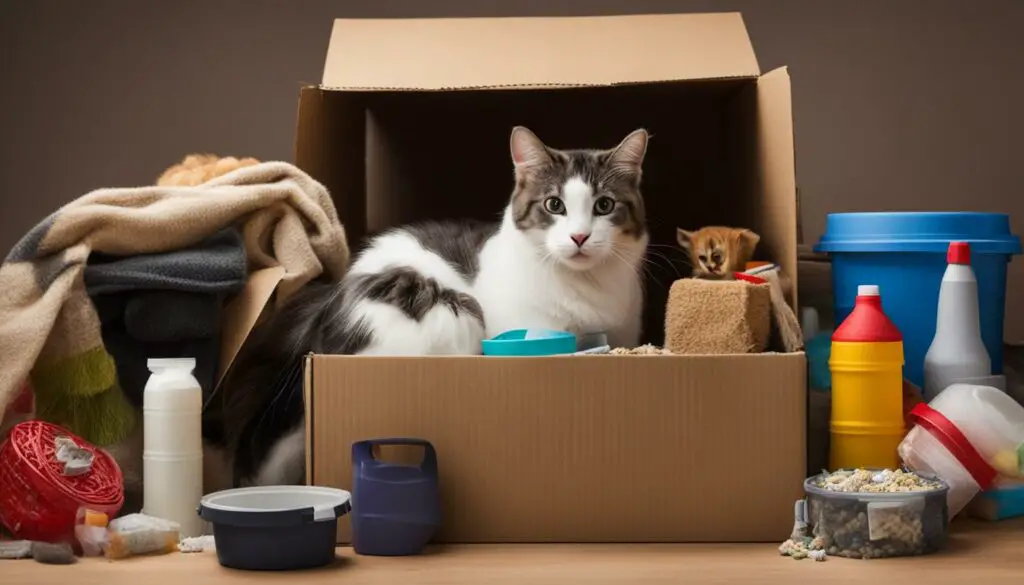
Testimonial
“Returning my TLC cat was a difficult decision, but the team at Ten Lives Club was understanding and supportive throughout the process. They truly care about the well-being of their cats and ensured a smooth return. I’m grateful for their commitment to finding the best homes for all their feline residents.”
Settling Your New Cat Into Their New Home
Adjusting to a new home can be a challenging process for cats. It’s important to remember that each cat has their own unique personality and adjustment period. Patience and understanding are key to creating a welcoming environment for your new furry friend. Here are some tips to help your cat settle into their new home:
- Give them a safe space: Set up a cozy and quiet area where your cat can retreat to when they need some alone time. This can be a separate room or a designated corner with a comfortable bed, toys, and a scratching post.
- Gradually introduce the rest of the house: Allow your cat to explore the rest of the house at their own pace. Start by opening the door to their safe space and letting them venture out when they feel ready. Make sure to supervise their exploration to ensure their safety.
- Stick to a routine: Cats thrive on routine, so try to establish a consistent feeding schedule and playtime. This will help them feel secure and can make the transition smoother.
- Provide vertical space: Cats love to climb and observe their surroundings from above. Consider adding cat shelves or a tall scratching post to give them a sense of security and a place to retreat.
Remember, it may take some time for your new cat to adjust to their new home. Some cats may be more outgoing and adapt quickly, while others may be more cautious and take longer to feel comfortable. Be patient, give them space when needed, and provide plenty of love and reassurance. With time, your new cat will settle in and become a cherished member of your family.
Quote: “Creating a peaceful and secure environment is crucial for helping your new cat feel at ease.” – Cat Lover
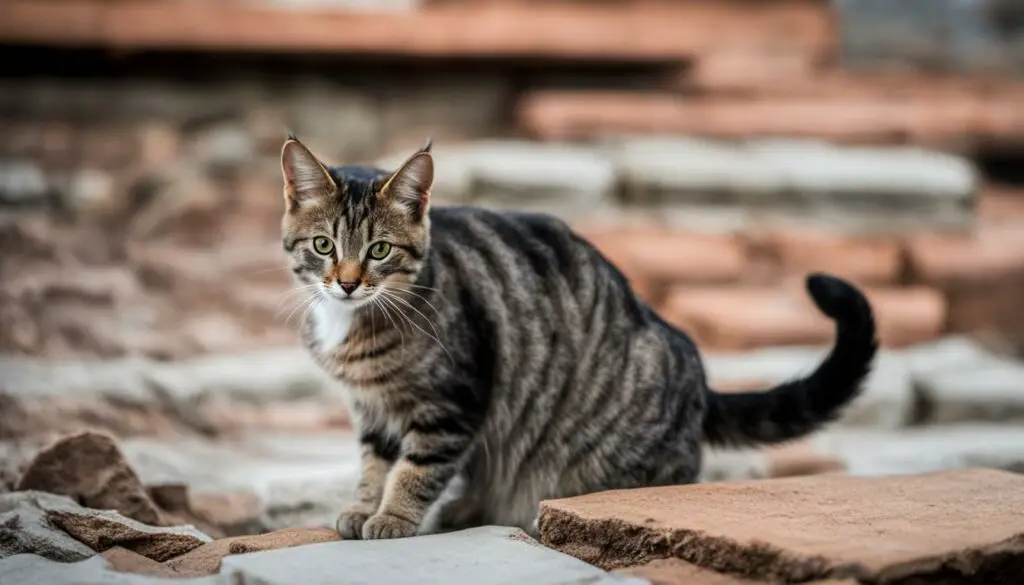
| Common Challenges | Helpful Tips |
|---|---|
| Refusing to eat or use the litter box | Ensure food and litter box accessibility, and give your cat time to adjust. |
| Hiding or excessive hiding behaviors | Provide hiding spots and quiet areas for your cat to retreat to, and avoid forcing them out. |
| Excessive vocalization or aggression | Give your cat time to settle in, and consult a veterinarian if these behaviors persist. |
| Marking or scratching furniture | Provide appropriate scratching posts and toys, and discourage destructive behaviors through positive reinforcement. |
Conclusion
Adopting a stray cat is a decision that not only brings joy and companionship to your life but also makes a difference in the lives of these deserving animals. While there may be costs involved in the adoption process, the rewards far outweigh the financial investment.
When considering adopting a stray cat, it’s important to take into account various factors such as adoption fees, veterinary care, and the source from which you are adopting. Animal shelters, private rescue groups, and reputable cat breeders are all options to explore, each with their own fees and requirements.
By opening your heart and home to a stray cat, you are not only providing them with a loving environment but also contributing to the important cause of combatting pet overpopulation. Every adoption helps break the cycle and shows that rescue cats are just as valuable as purebred cats. Your decision to adopt truly makes a difference.
So, if you’re ready to embark on this rewarding journey, consider adopting a stray cat and experience the unconditional love and companionship they have to offer. Remember, the bond you form with your adopted cat is priceless, and together, you can create a lifelong partnership filled with love and happiness.
FAQ
How much does it cost to adopt a stray cat?
The cost of adopting a stray cat can vary depending on the source. Adoption fees at animal shelters and private rescue groups can range from $0 to $200, while purchasing a purebred kitten from a breeder can cost between $300 and $1,500.
Where can you adopt a cat?
You can adopt a cat from an animal shelter, private rescue group, or a cat breeder.
What is included in the adoption fee at an animal shelter?
The adoption fee at an animal shelter usually includes veterinary care such as checkups, vaccinations, spaying or neutering, and microchipping. Some shelters may even run promotions waiving the adoption fee.
What is included in the adoption fee at a private rescue group?
The adoption fee at a private rescue group typically includes similar veterinary care as an animal shelter, such as checkups, vaccinations, spaying or neutering, and microchipping.
What is included in the adoption fee for a purebred kitten from a cat breeder?
The adoption fee for a purebred kitten from a cat breeder is usually higher than adopting from a shelter or rescue group. However, it may not include spaying or neutering or a microchip. It’s important to research and choose a reputable breeder who offers a health guarantee for the kitten.
What is the trap-neuter-return program for feral cats?
The trap-neuter-return program is aimed at reducing the number of feral cats through sterilization. It involves trapping, neutering or spaying, and returning feral cats to their environment.
What are the benefits of neutering programs for feral cats?
Neutering programs, such as trap-neuter-return (TNR), can improve the health of feral cats, reduce fighting and marking behaviors, and help with population control.
What are the controversies surrounding feral cat management?
There are debates over whether to eradicate or relocate feral cats or to implement trap-neuter-return programs. Relocation is often ineffective due to the “vacuum effect,” where new cats fill the abandoned territory.
How can I help stray cats in my community?
You can help stray cats by spaying and neutering your own cats, providing food and shelter to stray cats, volunteering with organizations that work with stray cats, or donating money to support their care.
Why should I choose to adopt a TLC cat?
By adopting a cat from Ten Lives Club (TLC), you are supporting their mission of furthering and enhancing cat life. Adopting a rescue cat helps break the cycle of pet overpopulation and shows that rescue cats are just as lovable and valuable as purebred cats.
How do I choose the right cat to adopt?
It’s important to consider the personality and temperament of the cat and assess whether they align with your lifestyle. Meeting the cat in person allows you to make a more informed decision.
What is the adoption process for a TLC cat?
To adopt a TLC cat, you can visit one of their adoption locations or browse their available cats online. After scheduling a meet and greet with an adoption coordinator, you will need to complete the adoption paperwork, including providing a valid driver’s license, a cat carrier, and payment for the adoption fee. You will also need to establish a primary veterinarian for your new cat.
How much are the adoption fees for TLC cats?
TLC’s adoption fees vary depending on the age and special needs of the cat. Fees range from $50 for senior cats or those with special needs to $195 for kittens. There are also pricing tiers for multiple cat adoptions. Additional fees may apply for declawed cats.
What if the adoption doesn’t work out?
If for any reason the adoption doesn’t work out, TLC will accept the return of their cats. They prioritize the well-being of the cats and want to ensure their success in a new home. Contact the shelter to discuss the return, although the adoption fee will not be refunded as it is considered a donation.
How long does it take for a new cat to adjust to their new home?
Cats may take around four weeks to adjust to their new homes. It’s important to be patient and provide them with a welcoming environment. Each cat is different, so understanding their needs and giving them space can make the transition smoother.
Source Links
- https://www.thesprucepets.com/how-much-does-it-cost-to-adopt-a-cat-5270274
- https://www.webmd.com/pets/cats/helping-stray-and-feral-cats
- https://www.tenlivesclub.com/faqs








